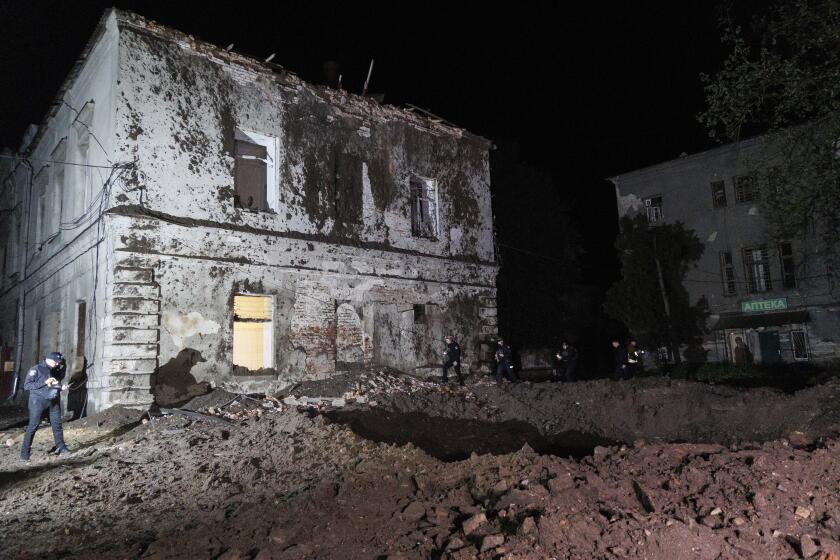Anti-Terrorism Command Takes Off
With little fanfare, the nation’s first military command dedicated solely to protecting against terrorist attacks on American soil is up and running.
More than 750 military personnel from all branches of the service are watching everything flying over the nation, all ships chugging around the globe and natural disasters as they unfold across the country.
If anything suspicious arises, the fledgling U.S. Northern Command, or Northcom, has the full force of the military at its disposal to confront threats in the air and seas of this country, Canada, Mexico and parts of the Caribbean.
“We want to take the fight to the terrorist,” said Air Force Gen. Ralph Eberhart, commander of Northcom based here. “We are all about deterrence.”
Northcom is headquartered in a sleek, modern building, but its heart lies in the top-secret situation-awareness center in the basement. Massive screens show thousands of airplanes flying over the country in real time. With the touch of a button, analysts can get a plane’s course, airline and destination.
Tail winds, speeds, pilot names and even cockpit conversations are monitored for indications of a hijacking. The same computers can also show every ship at sea and zoom in on those that may be suspicious.
“We can highlight any plane or ship we are interested in,” said Lt. Col. Ross Brown, who supervises the situation room, as he watched monitors along with dozens of uniformed military personnel. “This gives us a head start on any problem.”
Beside him were folders marked secret, which laid out procedures on how to intercept a plane, determine whether it’s been hijacked and then, if necessary, shoot it down.
“We have a series of tests for shooting down a plane,” Brown said.
Northcom commanders routinely undergo training on how to handle a hijacking and when to shoot down an airliner. They are graded on their performance.
A hijacked plane these days would likely meet a jet fighter dispatched from a nearby air base or part of round-the-clock patrols across the country.
Brown said the jet could shoot flares to get the pilot’s attention or fire warning shots. So far, he said, he has had five aircraft hit the squawk button indicating a hijacking in progress. Each time the button had been hit accidentally. If there is a hijacking, Northcom commanders must decide if the plane is going to land peacefully, if it’s headed for a building or if passengers are likely to overpower the assailants before officials give the order to shoot.
“Before Sept. 11 we never considered shooting down a civilian plane,” said Maj. Douglas Martin, a spokesman for the North American Aerospace Defense Command, or NORAD, a Cold War-era air defense unit based deep inside nearby Cheyenne Mountain and now part of Northcom. “We now talk with our pilots and tell them they need to have the nerve to pull that trigger.”
Martin said NORAD has scrambled jets 1,500 times since Sept. 11, 2001, which amounts to about 31,000 sorties. Those included jets sent up to escort the airliner carrying Richard Reid after his attempt to detonate a shoe bomb in flight.
Most intercepts involve small planes that stray into restricted airspace.
Eberhart looked pained when asked about shooting down civilian airliners.
“The pilots are briefed; they are asked if they can do this,” he said. “In the end, the pilots will save lives on the ground. They may save lives in a building. But the pilots will have to live with this for the rest of their lives.”
Northcom was hastily assembled in the aftermath of Sept. 11 with the goal of detecting and deterring another terrorist attack in America. It coordinates efforts with 21 federal and 15 military agencies and has a budget this year of $81 million. Representatives from the CIA, FBI and Defense Intelligence Agency all maintain offices at Northcom, where officials are briefed daily on potential terrorist threats.
Eberhart said one of the biggest challenges has been getting agencies to cooperate. “We have a long way to go,” he said. “But we ought not to be exchanging business cards at the scene of an incident.”
Though it only became fully operational two weeks ago, Northcom sent troops to help battle wildfires in Montana last summer. It also helped track Hurricane Isabel and provided secret listening and viewing devices during the search for suspects in the Washington-area sniper attacks.
“The FBI asked us if we could fly some super-secret planes over the area where the snipers were seen,” said Lt. Col. Shelly Stellwagen, a spokesman for Northcom. “We have a dual mission -- homeland defense and to work with civilian authorities where we can.”
Eberhart, who flew 300 combat missions in Vietnam, said one of his biggest fears was that public interest would wane after three or four years without an incident.
“We must continue to refine our operations and wonder what the terrorists thought of that we haven’t,” he said. “I draw the analogy of the Cold War. It was a war of decades, not a war of years. It will take the same commitment we had in the Cold War to win this war.”
More to Read
Start your day right
Sign up for Essential California for news, features and recommendations from the L.A. Times and beyond in your inbox six days a week.
You may occasionally receive promotional content from the Los Angeles Times.






